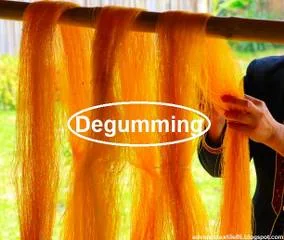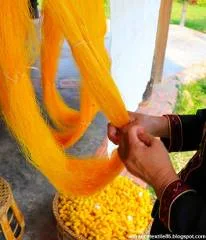Silk cocoon degumming
Silk
is a natural protein filament that can be converted into textiles by weaving or
knitting techniques. Silk protein fibers/filaments are mainly composed of
fibroin and some insect larvae are produced to make cocoons. For commercial
use, it belongs almost exclusively to the filament from cocoons produced by
various moth species of caterpillars, which belong to the genus Bombyx and are
commonly referred to as sericulture.
Silks
are the only natural filament or solid fiber and the filaments are 300-1800
yards long. Silk fiber has a double rod-like structure, it is covered with gum
glue. The wild silk fiber is very irregular and flat, with wavy ribbons
resembling longitudinal marks. Cultivated silk is smooth, cylindrical, and
usually uniform in thickness like glass rods.
Silk fiber contains about 20-25 percent sericin gum. Sericin is a group of soluble
glycoproteins that are expressed in the middle silk glands of the Bombay Mori.
Silk excreted by silkworms consists mainly of two proteins, sericin, and
fibroin; the structural center of the fibroin silk and the sericin gum coating
the fibers and allowing them to stick together.
Natural
glue, sericin is usually left on the silk during reeling, throwing, and
weaving. It acts as a size that protects the fibers from mechanical injury.
Once the insects are out the cocoons must be degummed before they can be spun
into yarn.
The process sequence of silk cocoon degumming
i. Removing short threads
Each
cocoon is surrounded by a short thread that the silkworm supports its structure.
These threads tend to be inferior so it is best to remove them before
degumming. They pull off quite easily.
ii. Degumming supports silk
Support
silk is degummed and can be used.
iii. Removal of larvae and
pupal skins
Thereafter,
larval and pupal skins must be removed from the inside of the cocoon. A pair of
hemostats comes in handy for this step. The cocoon fills the water and floats
the skins on top and prevents them from getting inside.
iv. Treat with soap
solution
Fill
a pot with water and add the same amount of soap - about 1/2 cup in 100
cocoons. It is important for us to use only natural soaps instead of detergents
that may contain harmful enzymes for silk or sodium lauryl sulfate. Some
recipes call for soda and/or lye washing but we have gotten good results using
only soap. Boil the cocoons until they fall to themselves and lose their shape.
It can take anywhere from 30 minutes to a few hours depending on the species of
silk. Make sure the cocoons are not boiled as this can cause them to tangle and
mat.
v. Extracting water, and
Drying
They
are sufficiently degummed when they look like fluffy cotton balls. Protein
fibers are best in acid conditions so add a splash of vinegar or acetic acid to
the final rinse water. About 1/4 cup per gallon of water. Rinse and gently
remove excess water and hang to dry.
vi. Pulling apart
They
will look good on the skin when dry, but we should be able to separate and
avoid them with our fingers. If not, repeat the degumming process. They are now
ready to spin.










0 Comments